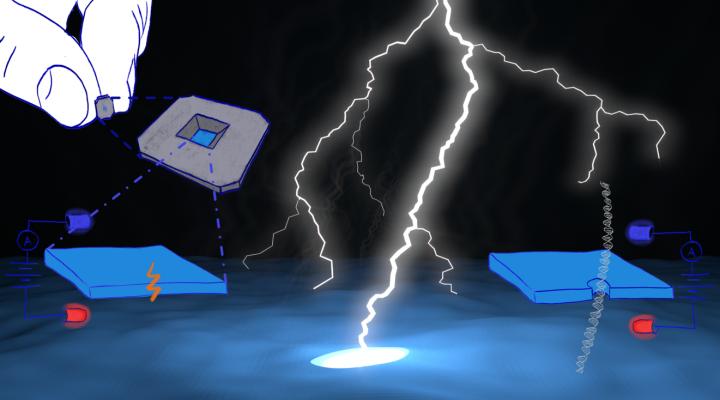
Credit: T.-Cossa Lab, Department of Physics, University of Ottawa
A nanopore is a tiny hole in a thin membrane with a diameter of around a billionth of a meter, or about the width of a single DNA molecule. The potential applications of these nanopores are so diverse – from medicine to information technology (IT) – that they could have a major impact on our daily lives. Now a team of researchers at the University of Ottawa is democratizing entry into the field of nanopore research by offering up a unique tool to accelerate the development of new applications and discoveries.
The innovative T.-Cossa Lab, which studies applied single-molecule biophysics, came up with the idea to provide the research community with the protocols, hardware designs, and software required to fabricate solid-state nanopores in a fast, low cost, and completely automated fashion. This method is now available in the online journal Nature Protocols.
The move is a boon for researchers developing diagnostic and sequencing applications in health, life sciences, and IT, where being able to detect and identify single biological molecules like proteins or DNA with the exacting precision of a nanopore is needed.
“For the first time, we are making our unique nanopore fabrication tool freely available,” explained Vincent Tabard-Cossa, professor in the Department of Physics and Director of the Laboratory for Applied Single-Molecule Biophysics at the University of Ottawa. “We opted to offer our patented nanopore fabrication technology to the research community for free, to help disseminate it and expand the field of nanopore research.”
Solid-state nanopores are now well established as single-biomolecule sensors which hold enormous promise for fast and low-cost sensing and sequencing applications, including rapid identification of pathogens, biomarker quantification for precision medicine, metagenomics, microbiome analysis, and cancer research. However, until recently, this promise had been stifled by the expensive, labor intensive, and low-yield methods by which pores were fabricated. To address this problem, Professor Tabard-Cossa and his team pioneered a cheap and scalable solid-state nanopore fabrication method in 2012 called controlled breakdown (CBD), which has since become the method of choice by which solid-state nanopores are fabricated by research groups around the world.
“To foster accessible innovation, we set out to make an instrument and workflow that could be operated successfully by someone who had never even heard of a nanopore,” said Matthew Waugh, lab manager of the T.-Cossa Lab. “We’ve already had some amazing successes through a local scientific outreach program where high school students have been able to independently produce nanopores and detect individual DNA molecules in a single afternoon using our tools.”
CBD pore fabrication replaces expensive, manually operated electron microscopes with low cost, easy-to-use, small benchtop instruments that automatically fabricate nanopores to a given size at the click of a button. According to Dr. Tabard-Cossa, researchers can now focus their attention on developing different real-world nanopore applications in various fields.
“One such application tackles the growing need to store and archive huge amounts of digital information for very long timescales,” said Kyle Briggs, postdoctoral fellow in the T.-Cossa lab. “Nature solved this problem a long time ago with DNA, and a similar approach will work for us, in which the information is stored as the sequence of a synthetic polymer, reducing server farms down to the size of a fridge and saving billions of dollars in energy costs and fried hard drives. Solid-state nanopores could enable the next major breakthrough in data storage since they can be used as the element that reads the information off the polymers,” he added.
Video: https:/
###
The paper Waugh, M., Briggs, K., Gunn, D. et al. Solid-state nanopore fabrication by automated controlled breakdown. Nat Protoc 15, 122-143 (2020) doi:10.1038/s41596-019-0255-2 was published in the January issue of Nature Protocols.
For media inquiries:
Justine Boutet
Media Relations Officer
Cell: 613.762.2908
[email protected]
Media Contact
Justine Boutet
[email protected]
613-762-2908
Original Source
http://media.
Related Journal Article
http://dx.




